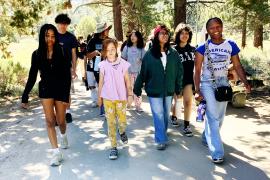As children and staff members are eager to return to camp to see familiar faces and places each summer, we often hear people comment about going back to their "summer home." Our camp homes are places where friendships are made, bonds are strengthened, skills are learned, and memories are created. Some of our summer homes have lakes, mountain views, and miles of trails, while others are set in the suburbs and some even right in the middle of cities. Creating a home is about the community you build and the culture you create among campers and staff, regardless of whether you rent or own your site.
Ten years ago, the Union for Reform Judaism camps — in partnership with the Foundation for Jewish Camp — entered the arena of leased facilities with the launch of the 6 Points Sports Academy in Greensboro, North Carolina. This camp was opened on the site of the American Hebrew Academy, a 125-acre boarding school. Many questioned whether the same youth outcomes could be achieved in a specialty camp on a rented site versus an owned space. The opportunity — and the challenge — was to create a home in what was actually someone else’s home. Since we opened our first URJ camp on a rented site in 2010, we have launched four more programs on rented sites throughout the United States. As other camps experiment with new models for their camp programs, our lessons learned from running camps in rented facilities can be considered.
Building the Relationship between Camp and Host Site
Considering sites for your camp goes far beyond the facilities themselves. The foundation of success is built on a strong relationship with your host. While the facility’s staff need not be involved in the daily activities and program of the camp renting the property (although this can be a great aspect of a rental site), it is important to forge connections with the host staff. At one of our camps, 6 Points Sci-Tech, we have built a rapport with our boarding school host that is both friendly and professional. Prior to our first year, we began by committing to communicating our needs and desires so we could best understand one another. Over time, the relationships between members of the camp staff and site staff have become stronger, as has our level of
trust in one another.
At a rented site, the camp director cannot change a mealtime without consulting the site partner, switch the number of beds in a bunk on a whim, or even do late-night snacks in the dining hall without careful planning. Part of building a trusting relationship is about being gracious and respectful. Simple gestures go a long way, such as:
- Ensuring tables in the dining hall are always clean (and when they aren’t, getting camp staff or campers to come back to help)
- Creating thank-you cards for security, grounds, and dining room employees
- Apologizing if you or a camper causes damage and offering to fix or replace the damaged item
We have also led one of our host school’s annual Passover Seders when camp was not in session, giving students from the school a new cultural opportunity and faculty a chance to get to know our staff. When your host becomes a true partner in seeing that your success is their success, both the camp and the host win.
There is no doubt that leasing your camp site from an existing school comes with many benefits, but, as with any relationship, there are challenges too.
Pros
While not an exhaustive list, following are some clear benefits to running camp from a rented school facility:
- We know our room and board costs prior to opening registration. This fixed cost includes security, kitchen staff, housing, meals, maintenance, and other facility-related costs normally incurred by the camp on their own sites.
- Our exposure to "big ticket" items is limited. When the roof needs repairing, trees need to be removed, or the gym floor needs repainting, the landlord will incur those costs.
- We don’t need to have an off-season rental business to help with the upkeep and expense of having a facility year-round, allowing us to focus on camp.
- Our lease agreement includes staff members in the kitchen, facilities, and security departments. This means we don’t have to hire cooks, janitorial staff, or security ourselves. (On a side note: In one case, the kitchen at our rented facility is kosher, so being able to have kosher campers attend is an additional asset.)
There are also big benefits for schools renting their spaces to camps beyond the extra income they bring in during the summer months when classes are not in session. Camp programs bring increased foot traffic by school-aged children and their families, and thousands of dollars of marketing exposure to the site.
Cons
The downside to operating camp at rented school facilities includes:
- Income is capped to the summer time, as the space is otherwise used by its year-round occupant.
- The rental facility dictates the camp calendar, and there is little flexibility. In our case, 6 Points specialty camps draw campers from all over North America, and a wide array of school calendars. As our camps must fit into the school sites’ available dates. Our host school in Boston, Massachusetts, has a very different school calendar to our host school in Greensboro, North Carolina.
- Camp does not have control over employees hired by the host site, so while it works well to have food costs predetermined, for example, the host site uses their staff and processes to cook the meal, serve the meal, and clean the dining hall after the meal.
- Potentially, other programs/camps/groups may use the same space, which can impact the culture and community camp is trying to build.
- The camp can’t build additional facilities (no extra dorms for more campers or secondary athletic facilities), nor does the camp have year-round storage space at the rental facility.
- Prospective families can’t visit the facility prior to camp. The scheduling of open houses must be coordinated well in advance, and must be convenient for both the camp and the school.
- Host sites consider the summer months as their time to complete projects that they cannot do during the school year. For example, one summer our host school in North Carolina decided to repair the only bridge that allowed for easy walking from one side of the facility to the other during our busiest session of the year. This was convenient for the school, but definitely not for us.
Personalizing Your Rented Space
Along those lines, one of the biggest challenges with a rental facility is replicating that sense that "this space is ours." While we chose our rental sites for their ability to accommodate and support the high-level specialty programs we run, we also utilize areas that are geared for events and activities vastly different from those for which we need them. Our task is to repurpose them to create that "camp feel," and we have found several ways to accomplish this goal, including signage, programming, and relationship building.
Working in partnership with your site, use removable and portable signage to delineate space and/or rebrand it. The camp core values can be displayed on pop-ups in the dining hall rather than affixed to a wall, a lawn sign turns an annex gym into the camp Sports Center, and a poster makes the school staff kitchen into the Teaching Kitchen. While the words to camp’s most popular anthems or cheers can’t be secured to the wooden beams of a gathering space, vinyl banners are visually appealing and allow campers and staff to participate with ease in any venue. They also provide opportunities for participants to have the honor of standing in front of their peers holding the corners as a reward for clean rooms, conquering a fear, or showing kindness to others. With programs like Canva and remote printing sites like Vistaprint, it is easy to design your own materials using your camp’s color schemes, fonts, and pictures, and to print them in a variety of sizes and modes fairly inexpensively. And while a permanent display recognizing your donors may not be possible, stakeholders can "name" a program rather than a building.
Dorm rooms are certainly not cabins, but bunk night and bedtime rituals can translate to these nontraditional areas with ease. Consider decorating doors of a string of rooms with a cohesive theme to give their occupants a group identity. Hall or floor names can also reinforce the idea of belonging to a specific group in camp, be that a cabin or unit. Color War may take place on the quad rather than a field, but it is still a day of sportsmanship, teamwork, and unity.
The songs we sing, the smiles, secret handshakes, and shared experiences are the sense memories we access when we reflect on growing up at camp. Ultimately, it is the relationships we help build that are the true heart of our programs. The investment we make by operating at a rental site may not be in plant development, but we certainly double down on human capital to enhance the powerful feeling of belonging we recognize as uniquely "camp."
Photo courtesy of Camp Realize Your Beauty, Estes Park, Colorado.
Danny Herz, MA, CAA, is the director of 6 Points Sports Academy, which is housed at the American Hebrew Academy in Greensboro, North Carolina. Prior to his full-time role at camp, Danny held jobs as a teacher, coach, dean of students, and athletic director.
Jo-Ellen Unger, MARE, is the director of URJ 6 Points Creative Arts Academy, held at Westtown School in Westchester, Pennsylvania. Jo-Ellen herself is an accomplished artist and educator, having developed her skills at the Performing and Visual Arts Center (now New World School of the Arts) in Miami, Florida, the Fine Arts program at Florida State University, and the National Shakespeare Conservatory in New York City.
Greg Kellner, MPA, is the former director of URJ 6 Points Sci-Tech Academy, which is held at Governors Academy in Massachusetts. Before joining the 6 Points team, Greg served as the senior assistant director of the URJ Crane Lake Camp and as the assistant director of the URJ Eisner Camp.



